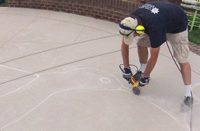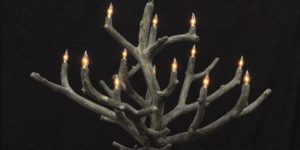
Gerald Parker says he became more creative with concrete. Using a sand mold, concrete could be formed into any shape. With his Fine Arts degree and background with work as a mason, he decided to make pottery.
Gerald Parker graduated from the Boston Museum School of Fine Arts 35 years ago, well before the decorative concrete movement hit its stride. So when he went looking for work in the small town where he lived, the only job he found was as a laborer for a local mason.
 But his schooling didn’t stop there. “As my skills in the trade and my understanding of the medium increased, it became apparent that I could become more creative with concrete,” he says. “Using a sand mold, concrete could be formed into any shape. With dry masonry pigments, mixing the primary colors any hue could be created. Concrete finishing products could brighten the dry colored concrete.”
But his schooling didn’t stop there. “As my skills in the trade and my understanding of the medium increased, it became apparent that I could become more creative with concrete,” he says. “Using a sand mold, concrete could be formed into any shape. With dry masonry pigments, mixing the primary colors any hue could be created. Concrete finishing products could brighten the dry colored concrete.”
What to do with this newfound knowledge? Parker decided to make pottery.
“At first I created a sand mold within a box-shaped wooden form,” he says. “With a wooden template attached to a metal pole a perfect outer shape could be made. Other times, I would simply remove sand to create something free-hand-mold.
“After the mold is created, I dilute a mixture of concrete colors and apply them directly on the sand mold using squirt bottles. When my design is complete, I build up a two-inch-thick wall, filling the center with sand to keep the wall from slumping. I continue this way until I reach the top of the box form. After a period of curing time, I remove the box form, pull back the sand mold, both inside and out, and lightly scrape the pottery with a flat brick jointer to reveal the design.
 “Another method I prefer which allows more flexibility is the upside-down technique. I dome a mound of damp sand on a workbench to the shape I desire. Using a hand trowel, I plaster four coats of cement consisting of a concrete-sand mix around the pottery, using wire between the second and third coat. After this is complete, I mix small portions of colored cement and apply this with a flat brick jointer directly on to the piece. This wet-on-wet technique allows infinite creative possibilities to achieve any design.
“Another method I prefer which allows more flexibility is the upside-down technique. I dome a mound of damp sand on a workbench to the shape I desire. Using a hand trowel, I plaster four coats of cement consisting of a concrete-sand mix around the pottery, using wire between the second and third coat. After this is complete, I mix small portions of colored cement and apply this with a flat brick jointer directly on to the piece. This wet-on-wet technique allows infinite creative possibilities to achieve any design.
“Other techniques allow me to hand carve designs before the curing time has elapsed.”
(508) 224-2540
www.supremephotography.net















